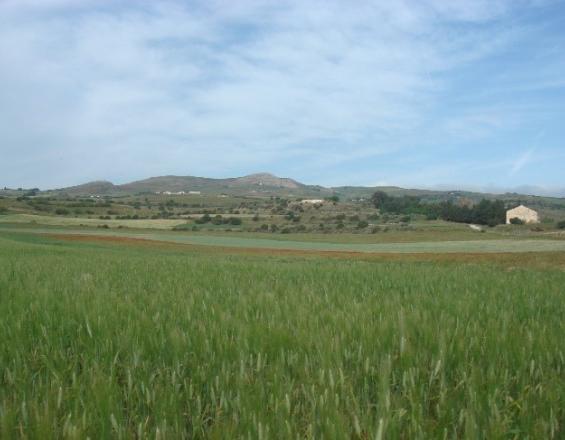
La agricultura de conservación utiliza tecnologías locales para aumentar la productividad con menos recursos.

Si se gestiona adecuadamente, la agricultura de conservación suele ser una situación en la que tanto los agricultores como el medio ambiente salen ganando. La agricultura de conservación, a menudo asociada a la ganadería o a tecnologías locales como las sembradoras de labranza cero, aumenta la productividad de los cultivos, mejora la eficiencia en el uso de los recursos y la salud del suelo. Como alternativa a la labranza convencional (LC) para las tierras secas de secano, evita el laboreo del suelo, ahorra tiempo y mano de obra y conserva el agua y los nutrientes del suelo para que la producción de cultivos sea más resistente al cambio climático.
Contexto
Défis à relever
El cambio climático, las condiciones ambientales erráticas y el crecimiento demográfico ejercen presión sobre los sistemas agrícolas. Como consecuencia de la sobreexplotación para satisfacer la demanda, los suelos se empobrecen, lo que reduce la productividad. Esto es especialmente cierto en los países de renta baja y media del norte de África y de América Latina y el Caribe, donde la población rural es muy vulnerable a unas precipitaciones impredecibles y variables. La mayor frecuencia de sequías y fenómenos meteorológicos extremos, así como la evolución de la demanda y las preferencias alimentarias, afectan aún más a la producción de cultivos y degradan la biomasa. La agricultura de conservación puede hacer frente a estos retos. Utilizada por la mayoría de los agricultores en Australia y Brasil, y por muchos en Norteamérica y otros países de renta media y alta, esta solución tiene el potencial de mejorar la seguridad alimentaria y preservar los recursos naturales en los agroecosistemas de las tierras secas de Asia Central y Occidental, Oriente Medio y el Norte de África y el África Subsahariana.
Ubicación
Procesar
Resumen del proceso
La agricultura de conservación y la formación relacionada con esta práctica ayudan a minimizar la perturbación del suelo, conservando los residuos de los cultivos para mantener la cubierta del suelo y la rotación de cultivos, mientras que la maquinaria local de labranza cero ayuda a complementar el impacto positivo relacionado con la práctica como una solución complementaria que complementa la solución principal. La tecnología diseñada utiliza insumos y habilidades mecánicas locales para ampliar los mercados de reparaciones y servicios técnicos y crear puestos de trabajo locales. Como se ha visto, los agricultores que cambian a la agricultura de conservación necesitan ayuda química para controlar las malas hierbas, lo que podría ser económicamente menos rentable para ellos, por lo que el desarrollo de puestos de trabajo locales relacionados con la maquinaria relacionada con la conservación puede ayudar a equilibrar este cuello de botella. La formación en la que participan los agricultores les capacita para desarrollar mercados locales y maquinaria que complementen las prácticas de la agricultura de conservación.
Bloques de construcción
Formación de agricultores
Al formar a los agricultores en agricultura de conservación, aprenden nuevas prácticas agronómicas inteligentes para diversificar los sistemas de cultivo, ahorrar energía y mano de obra y estabilizar los rendimientos en condiciones de secano.
Factores facilitadores
- Integración de un enfoque de género
- Participación de los agricultores en la formación
- Formación en técnicas de agricultura de conservación
Lección aprendida
Para los productores y las autoridades comunitarias existen demandas específicas de información, formación, diálogo y coordinación de actividades. Se necesitan enfoques innovadores de desarrollo agrícola para informar y demostrar a los agricultores los beneficios de la agricultura de conservación. Esto puede lograrse mediante actividades como Orientación intensiva de los agricultores para cambiar la herencia agrícola convencional de siglos de antigüedad. Formación en el puesto de trabajo y creación de "servicios de agricultura de conservación" para los agricultores en ámbitos como la siembra y el control de las malas hierbas y para el apoyo en torno a otras cuestiones prácticas para la adopción de prácticas de conservación.
Tecnología diseñada por los agricultores locales
Las sembradoras de labranza cero de producción local y bajo coste utilizan piezas y conocimientos mecánicos disponibles localmente para ampliar los mercados de reparaciones y servicios técnicos y crear puestos de trabajo locales. Este elemento básico ha permitido favorecer las subvenciones a la maquinaria agrícola de conservación y retirar las ayudas a las asignadas en prácticas convencionales. Una de las innovaciones complementarias de esta solución como práctica es una sembradora de bajo coste y labranza cero producida localmente. El Centro Internacional de Investigación Agrícola en Zonas Áridas trabajó con socios nacionales y agricultores líderes para desarrollar, probar y promover las sembradoras diseñadas o modificadas localmente. La tecnología diseñada utiliza insumos y habilidades mecánicas locales para ampliar los mercados de reparaciones y servicios técnicos y crear puestos de trabajo locales.
Factores facilitadores
- Trabajar con los agricultores para desarrollar, probar y promover las sembradoras modificadas que acompañan a la AC
- Promover los recursos locales
- Formar a los agricultores en el uso y las prácticas agronómicas
Lección aprendida
En cuanto al liderazgo y la concienciación, el liderazgo para coordinar los esfuerzos para revertir la degradación de la tierra está disperso y no se reconoce adecuadamente. Por lo tanto, se necesitan iniciativas y herramientas locales para aumentar la implicación y la sostenibilidad de la solución. La tecnología local incluida en esta solución, una sembradora de bajo coste y labranza cero, ha permitido empoderar a la población local mediante la creación de puestos de trabajo y el uso de insumos locales.
Impactos
- Sembradora de labranza cero: En comparación con las máquinas importadas, las sembradoras diseñadas por los agricultores locales producen rendimientos similares, pero presentan una mayor capacidad de ajuste de la siembra y un mayor índice de germinación.
- Mayor rendimiento: En Jordania, donde la producción de trigo se ve a menudo limitada por sequías prolongadas, los agricultores de Irbid obtuvieron rendimientos medios un 16% superiores a los obtenidos con prácticas convencionales, lo que generó unos beneficios netos de 296 dólares por hectárea.
- Apoyo gubernamental: Después de que los ensayos demostraran un aumento del 19% en el rendimiento del trigo, los responsables políticos marroquíes están incluyendo la agricultura de conservación en un esfuerzo nacional para invertir la caída de la productividad agrícola y estabilizar los rendimientos.
- Creación de empleo local: La tecnología diseñada por los agricultores asociada a la agricultura de conservación utiliza piezas y conocimientos mecánicos disponibles localmente, lo que crea puestos de trabajo al ampliar el mercado de reparaciones y servicios técnicos.
- Formación: Casi 1.200 mujeres agricultoras y 600 jóvenes agricultores recibieron formación en América Latina y en la región de Oriente Próximo y Norte de África.
- Rentable: La agricultura de conservación reduce los insumos y la carga de trabajo de los agricultores.
Beneficiarios
Los usuarios de la tierra y los agricultores son los destinatarios de esta solución.
Objetivos de Desarrollo Sostenible
Historia
Los usuarios de la tierra que han adoptado la Agricultura de Conservación (AC) han indicado que aprecian enormemente la reducción del trabajo, así como el coste de la mano de obra y del combustible. En Túnez, Adnen Abdrabbou abandonó los sistemas agrícolas tradicionales. En su lugar, empezó a practicar la AC. Puso su explotación a disposición del ICARDA y de tres institutos nacionales de agricultura (el Instituto Nacional de Investigación Agronómica de Túnez, el Instituto Nacional de Grandes Cultivos y la Escuela Superior de Agricultura de Kef) para realizar ensayos de AC in situ. A Abdrabbou, la implicación de los institutos le dio confianza y se convirtió en el primer agricultor tunecino pionero de la técnica. Uno de los ensayos ha durado dos décadas, lo que lo convierte en el ensayo de AC más conocido del país.
"Como agricultores, tomamos prestada la tierra por poco tiempo, y somos responsables de cuidarla hasta que se la entregamos a nuestros hijos y a sus hijos", afirmó.
















